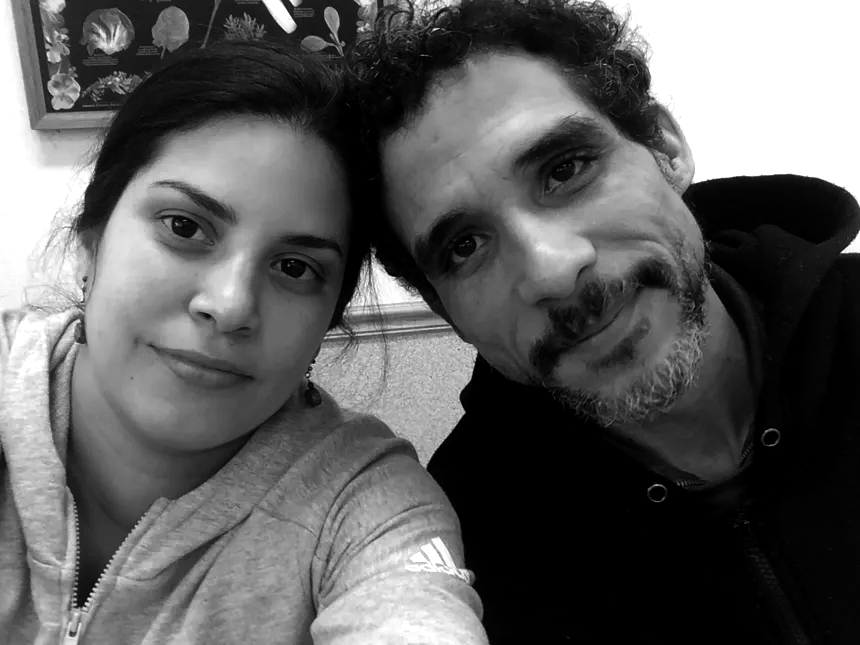
Photograph taken from his Facebook wall
Yesterday—quite late in the day—I learned of the tragic passing of the artist Rewell Altunaga through a post by Jesús Hdez‑Güero, another Cuban creator based in Madrid. Hdez‑Güero shared the article CNN published just yesterday on its digital edition. The piece, written by Ray Sánchez—a Puerto Rican journalist who once reported from Havana for the network—notes that he would often come across Rewell on the streets of West Harlem, in northern Manhattan.
The article—From Camagüey to Harlem: The Legacy and the Wound of Rewell Altunaga—is filled with details that color it with emotional depth. I offer a brief summary:
Altunaga was born in Camagüey, Cuba, in 1977. Trained in painting, ceramics, and photography, he became a professor and later deputy director at the Academy of Visual Arts in Ciego de Ávila. There he met the young artist Naivy Pérez, with whom he shared years of life and projects. Those who knew him then remember a fiercely intense creator, for whom art was never a profession but an irrepressible vital drive.
In many ways, his work was ahead of its time. He was a pioneer in using video‑game elements as artistic material, creating works that engaged with Delta Force, Vice City, or Arma 2. In a country like Cuba, where technology is scarce and prohibitively expensive, Altunaga forged unexpected paths for a generation of artists, weaving digital culture and aesthetic experimentation with a sharpness that sought no applause—only authenticity and truth.
By 2013, already recognized, he co‑curated the exhibition Cuban Virtualities at Tufts University, exploring the unlikely creativity born of the island’s technological scarcity. Colleagues like curator Liz Munsell remember him as generous and extraordinarily lucid. His legacy, discreet though it may be, left a trace that today offers another lens on the contemporary art of his generation.
In 2014 he emigrated to the United States with hopes of a different future. He arrived with dreams of study and creation, but also with a vulnerability that soon became painfully evident. New York greeted him with both light and shadow: the struggle to adapt, the distance from his son, and a sense of isolation intertwined with old temptations. Drugs crossed his path, and in time he lost the stability and the inner compass that once guided him.
Those who knew him closely emphasize his humanity. Friends like Julio Llopiz‑Casal describe him as one of the most valuable artists of his generation, someone who never turned his work into a media spectacle. Even when addiction took hold, he conceived projects to help the homeless, distributing survival kits and sharing what little he had.
But the spiral was relentless. Between episodes of fragile mental health, arrests, and the harshness of life in Harlem, Altunaga drifted away from art to the point of destroying hard drives containing his own work. And yet, the memory of his art survived thanks to those who salvaged those files, knowing their historical and creative value.
On June 17, 2024, his body surfaced in the Hudson River. His death, marked by mystery and marginality, stands in stark contrast to the richness of his legacy. His ashes rest today in an apartment in Harlem, not far from where he spent his final days. He was 47.
Altunaga embodies the story of so many artists who, far from home, become trapped between precarity and the urge to create. His life stands as testimony to both human strength and fragility—a reminder that talent alone is not always enough to sustain a dignified existence in adverse contexts. Those who loved and admired him refuse to dwell on the spectacle of his fall; they vindicate instead the profound mark he left on Cuba’s visual culture and in the memory of those who, even without knowing him, believe that art—even in defeat—continues to illuminate the world.
Leaving aside many deeply moving details, the summary above allows us to glimpse his story. It is true that—for artists arriving in the United States from Cuba—the collision with a society driven by compulsive competitiveness, where almost all available time is spent working merely to remain, to barely survive, can be devastating.
If, on one hand, the new country frees you from every tether, it also frees you from every excuse. From the very first day it penalizes hesitation, procrastination, those essential moments of idleness where personal poetics are often forged. There is scarcely time—not even to make art, but simply to be.
I too have known, as so many have, the doubt, the blindness, the darkness clouding the mind; real and imagined threats that linger for years. Like many others, on certain days I entertained the thought of a violent exit: to return to Cuba, to leap from a bridge… occasional fantasies that only a few bring to reality. I do not say this was his case—far from it. I knew only secondhand of the protagonists of this story and their works; I never had the privilege of meeting them.
But I do know—and I see myself in them—many creators of exquisite sensitivity and immense talent who flounder in a sea of doubt, clinging to a fragile confidence, to a now‑dim self‑esteem that once dazzled many eyes. This is not an easy country. A dear young woman once told me, in a parking lot near the Coral Gables Museum: You can’t afford a moment’s distraction. The smallest of them will cost you a lot of money, and as a permanent state, it will cost you your life.
That is why I wish for my friends who are still climbing—and for myself as well—that God may grant us the strength, through work and will, to break free from the chains of mere survival and move forward, unshackled, toward the fullness of creation.
CNN article at:
https://www.cnn.com/2025/07/19/us/the-tragic-demise-of-squirrel-man-a-cuban-artist

Naivy Perez and Rewell Altunaga, after the artist began living on the streets of New York City. Courtesy Naivy Perez










Comments powered by Talkyard.